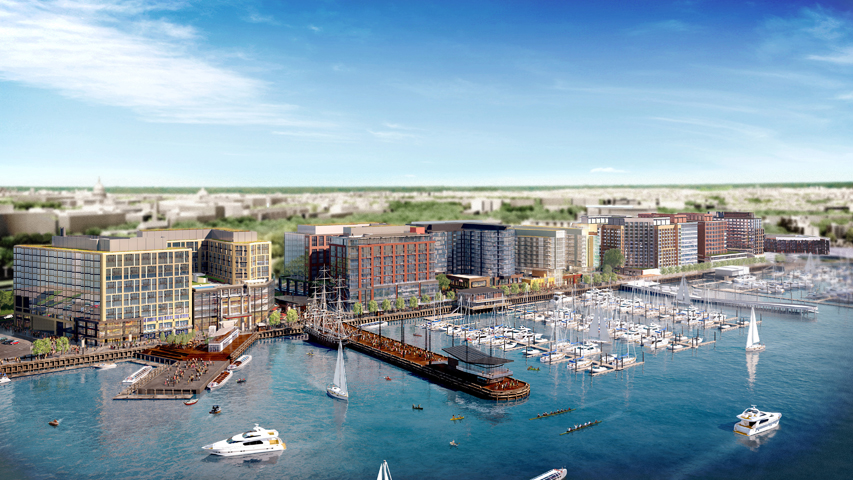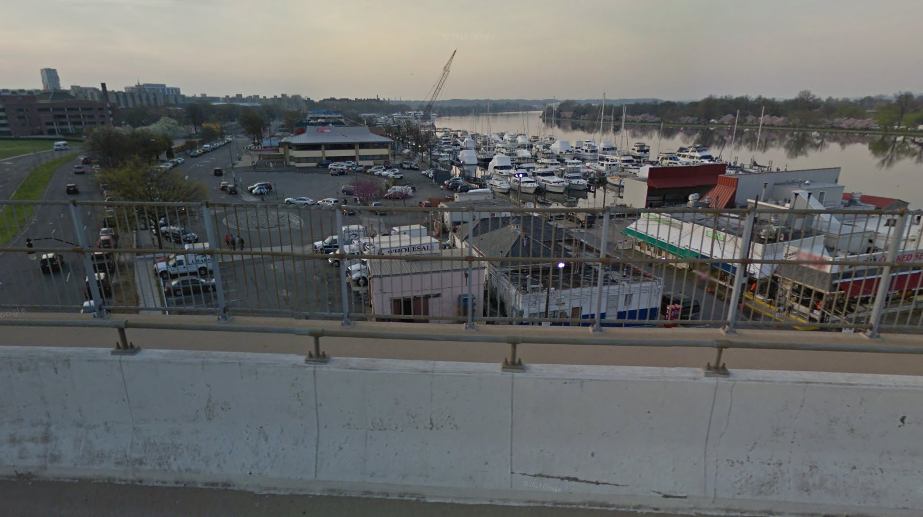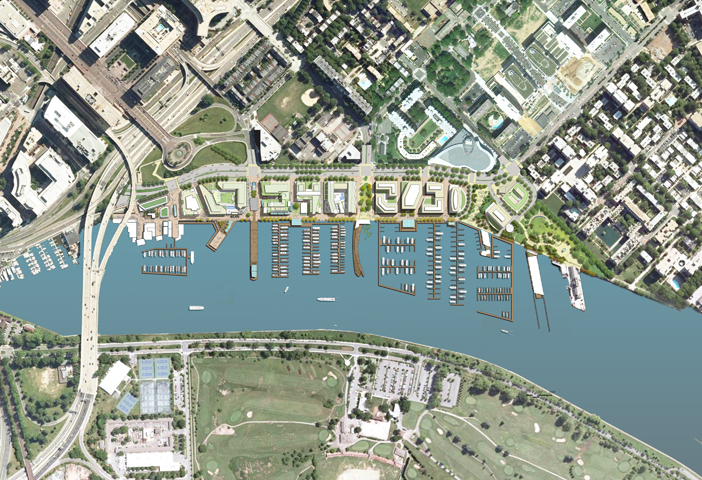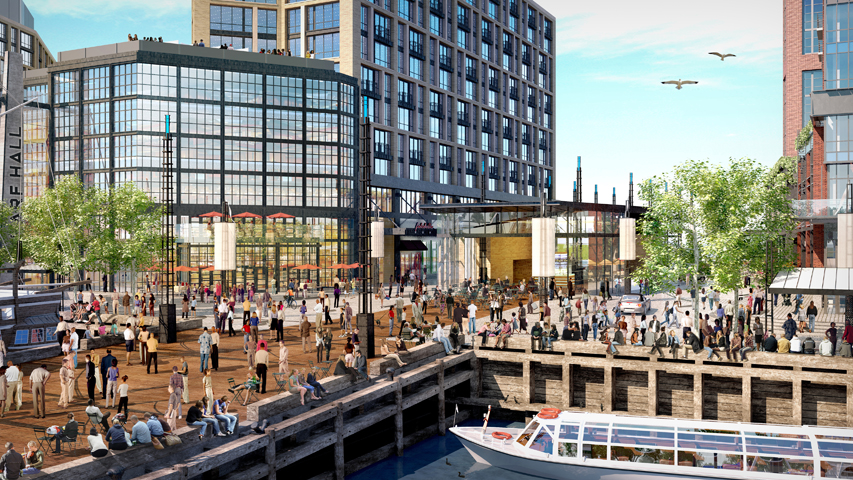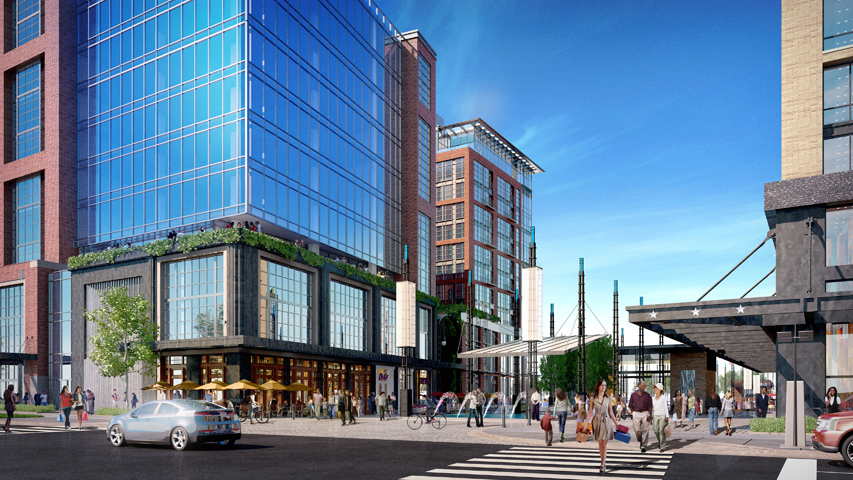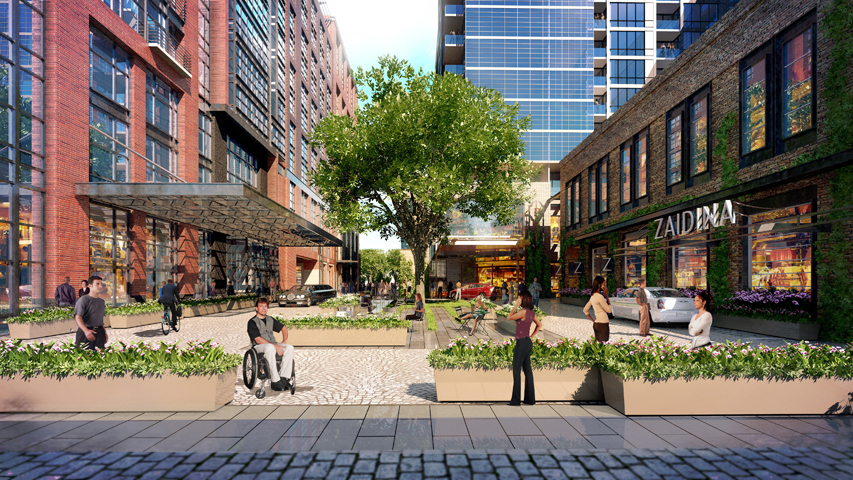With the I-395 overpass and expansive parking lots, Washington D.C.’s southwestern waterfront is more car-oriented than it is maritime. Because of this, the capital’s waterfront is missing out on the vibrancy of other cities by the water, such as Copenhagen, Venice, or Seattle.
The Wharf, a new wharf plan for the District, aims to change this scenario. The project, a team effort including the District of Columbia, Perkins Eastman and developer Hoffman-Madison Marquette, will transform the car-dominated streets into a complex of “shared space.” Greater Greater Washington reports that the street planning gives pedestrians priority, using subtle but effective visual cues instead of curbs and traffic signals. Paving selection that helps differentiate pedestrian, vehicular, and shared spaces is a key aspect.
The mixed-use complex will house retail, offices, housing, and public spaces such as parks and an extensive waterfront promenade.
The project broke ground in March 2014 and will be built in phases, with completion slated for 2020.
Visit The Wharf's official website for more information.
The current, car-dominated southwestern waterfront. Photo via Google Maps.
Ground plan of the Wharf. Courtesy of Perkins Eastman.
A view of the Civic Commons. Courtesy of Perkins Eastman.
Maine Avenue. Courtesy of Perkins Eastman.
The "Jazz Alley" at night. Courtesy of Perkins Eastman.
A piazza. Courtesy of Perkins Eastman
Related Stories
Designers | Sep 5, 2023
Optimizing interior design for human health
Page Southerland Page demonstrates how interior design influences our mood, mental health, and physical comfort.
K-12 Schools | Sep 5, 2023
CHPS launches program to develop best practices for K-12 school modernizations
The non-profit Collaborative for High Performance Schools (CHPS) recently launched an effort to develop industry-backed best practices for school modernization projects. The Minor Renovations Program aims to fill a void of guiding criteria for school districts to use to ensure improvements meet a high-performance threshold.
Market Data | Sep 5, 2023
Nonresidential construction spending increased 0.1% in July 2023
National nonresidential construction spending grew 0.1% in July, according to an Associated Builders and Contractors analysis of data published today by the U.S. Census Bureau. On a seasonally adjusted annualized basis, nonresidential spending totaled $1.08 trillion and is up 16.5% year over year.
Sports and Recreational Facilities | Sep 1, 2023
New Tennessee Titans stadium conceived to maximize types of events that can be hosted
The new Tennessee Titans stadium was conceived to maximize the number and type of events that the facility can host. In addition to serving as the home of the NFL’s Titans, the facility will be a venue for numerous other sporting, entertainment, and civic events. The 1.7-million sf, 60,000-seat, fully enclosed stadium will be built on the east side of the current stadium campus.
Mass Timber | Sep 1, 2023
Community-driven library project brings CLT to La Conner, Wash.
The project, designed by Seattle-based architecture firm BuildingWork, was conceived with the history and culture of the local Swinomish Indian Tribal Community in mind.
Office Buildings | Aug 31, 2023
About 11% of U.S. office buildings could be suitable for green office-to-residential conversions
A National Bureau of Economic Research working paper from researchers at New York University and Columbia Business School indicates that about 11% of U.S. office buildings may be suitable for conversion to green multifamily properties.
Adaptive Reuse | Aug 31, 2023
New York City creates team to accelerate office-to-residential conversions
New York City has a new Office Conversion Accelerator Team that provides a single point of contact within city government to help speed adaptive reuse projects. Projects that create 50 or more housing units from office buildings are eligible for this new program.
Codes and Standards | Aug 31, 2023
Community-led effort aims to prevent flooding in Chicago metro region
RainReady Calumet Corridor project favors solutions that use natural and low-impact projects such as rain gardens, bioswales, natural detention basins, green alleys, and permeable pavers, to reduce the risk of damaging floods.
Adaptive Reuse | Aug 31, 2023
Small town takes over big box
GBBN associate Claire Shafer, AIA, breaks down the firm's recreational adaptive reuse project for a small Indiana town.
Giants 400 | Aug 31, 2023
Top 35 Engineering Architecture Firms for 2023
Jacobs, AECOM, Alfa Tech, Burns & McDonnell, and Ramboll top the rankings of the nation's largest engineering architecture (EA) firms for nonresidential buildings and multifamily buildings work, as reported in Building Design+Construction's 2023 Giants 400 Report.


